Nothing gives customers “the ick” about a brand faster than a difficult shopping experience. It’s all about creating an exceptional user experience, no matter which channel they choose.
With omnichannel e-commerce, you can give customers more flexibility and control over how they shop with you. Whether they’re browsing your website on their laptop, using your mobile app, visiting your brick-and-mortar store, or engaging with you on social media, omnichannel e-commerce creates a consistent and stellar customer experience (CX).
With help from our guide, you can develop the right omnichannel e-commerce strategy — and take your omnichannel contact center and customer experiences to the next level.
Where Do You Rank on the AI Maturity Curve?
Take the 5-minute assessment and get a personalized score and recommended next steps.
What Is Omnichannel E-commerce?
Omnichannel e-commerce is a retail strategy that unifies the customer experience across online and offline channels for a great shopping journey. These channels range from digital channels like online stores, social media channels, live chat, and email to traditional channels, like phone and physical stores.
Simply put, omnichannel e-commerce prioritizes the customer journey, making the digital customer experience and in-person CX better. It makes it easy for customers and businesses to stay connected, no matter the channel.
It ensures conversations flow seamlessly, even if they shift from one platform to another. When customers are satisfied, that leads to improved customer engagement, increased retention, better sales, and higher customer lifetime value (CLV).
A prime example is Disney, which integrates its theme parks, online store, mobile app, and social media presence to create a magical and consistent customer experience.
Related: How to Improve Your Ecommerce Customer Experience
What’s the Difference Between Traditional vs. Multichannel vs. Omnichannel E-commerce?
Now that we know the meaning of omnichannel e-commerce, let’s talk about traditional and multichannel e-commerce and what makes them different from each other. But first, let’s define traditional and multichannel e-commerce:
🏬 Traditional e-commerce, also known as single-channel e-commerce, takes a straightforward, classic approach to online shopping. Customers browse products on a single platform—typically a website—add them to an online shopping cart and complete the checkout process. It’s simple, direct, and focuses on one primary digital storefront.
💬 Multichannel e-commerce: Multichannel e-commerce expands on the traditional model by offering customers multiple ways to shop and interact with a business. These channels could include a website, social media platforms, online marketplaces, and even physical stores. However, these channels operate independently, resulting in inconsistent interactions depending on the customer’s channel.
For example, an item saved in a shopping cart on the website may not appear in the app, creating a disconnected experience.
The main distinction isn’t how many channels but how the channels work together.
- Traditional e-commerce focuses on a single platform, providing a straightforward but limited experience.
- Multichannel e-commerce offers multiple platforms, but they often operate in silos, leading to fragmented interactions.
- Omnichannel e-commerce integrates all platforms, data, and context, delivering a consistent and unified omnichannel customer experience.
Each method serves different business needs, but an omnichannel approach is the best for delivering experiences that customers expect.
Recommended: How Multichannel Marketing Impacts the Customer Experience
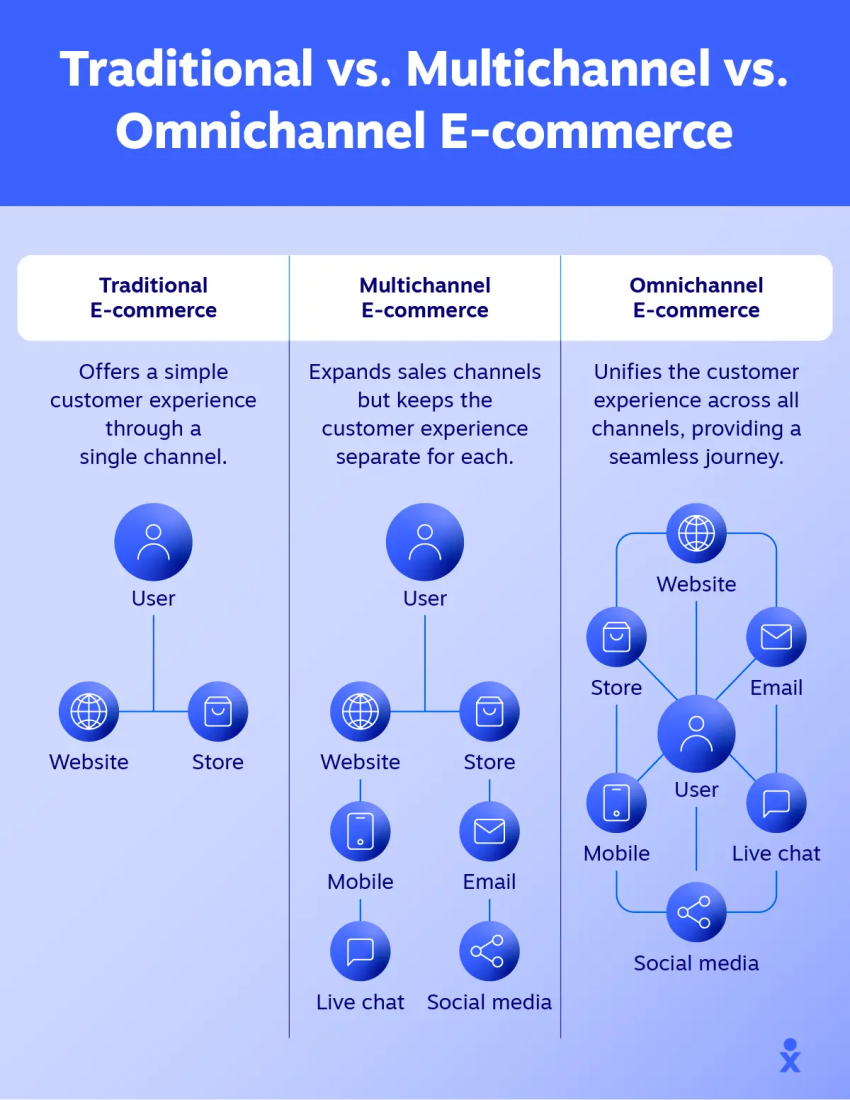
The Benefits of Omnichannel E-commerce
With omnichannel e-commerce, you can reap a variety of benefits. Here are a few.
Increase sales and traffic
According to a report by ServiceNow and Dell Technologies, customers spend an average of 83% more in-store compared to online. Omnichannel e-commerce bridges the gap between in-store and online sales, creating consistent shopping experiences across multiple channels. The result? Higher sales and traffic and increased brand visibility. Being where your customers already are and making it easy and convenient for them to interact and make purchases enables you to drive traffic to your site and increase conversions.
Integrating data collected from different channels helps you identify cross-selling and upselling opportunities. For example, agents or chatbots can use customer data, like purchase history or browsing behavior, to recommend products or upgrades, increasing the average order value.
Provide better insights
Unified customer data provides deeper insights into your customers, allowing you to understand them better and provide more personalized experiences. With this valuable data, like customers’ purchase history, browsing habits, and previous interactions across your website, app, and social media platforms, you can tailor marketing campaigns and personalize recommendations, driving higher engagement and conversion rates.
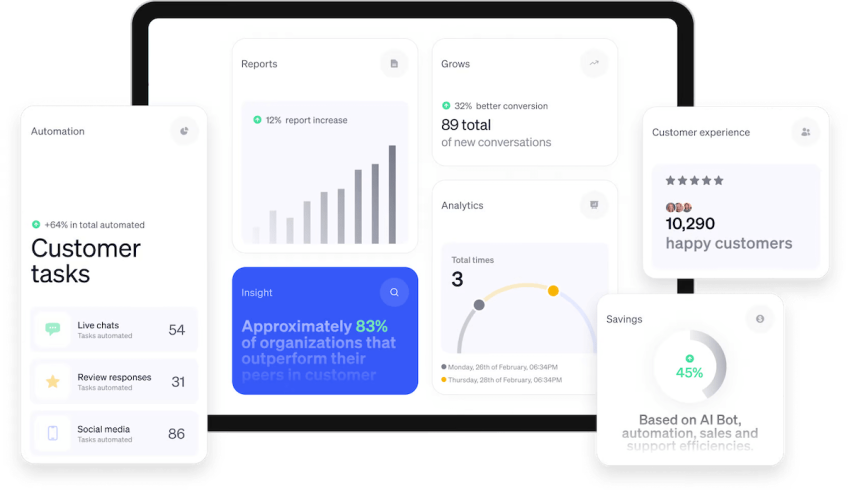
Using omnichannel analytics software allows you to monitor conversations in one place and identify customer needs, sentiment, and intent in real time. Social listening tools can add to these insights by tracking customer discussions, trends, and feedback across social media platforms.
Enhance customer experience
Omnichannel e-commerce allows customers to easily switch between channels, access their order history, receive personalized recommendations, complete purchases, and get support. Whether the customer interacts with your brand through social media, email, live chat, text, or in-person, the customer experience remains consistent.
The ServiceNow and Dell Technology report also found that 62% of consumers turn away from retailers when they have unpleasant experiences. That makes delivering top notch customer experiences consistently even more important. For example, say a potential customer sees one of your products on Instagram and follows the link to your website, where they sign up for your email newsletter. You can automate an email reply that offers customers a discount code and links them directly to the product they were browsing.
Drive repeat purchases and enhance brand loyalty
The more effortless the shopping experience, the greater the likelihood of repeat customers. A convenient and consistent brand experience improves customer satisfaction and builds loyalty, keeping them coming back (and recommending you to their friends, family, or followers). Positive online reviews amplify this effect by building trust and encouraging new customers to try your brand.
Encouraging happy customers to leave reviews can boost your reputation, attract more buyers, and reinforce customer loyalty. Plus, personalized recommendations and suggestions drive traffic back to your site, increasing customer lifetime value.
Recommended: How to Respond to Positive Reviews: 24 Templates + Tips
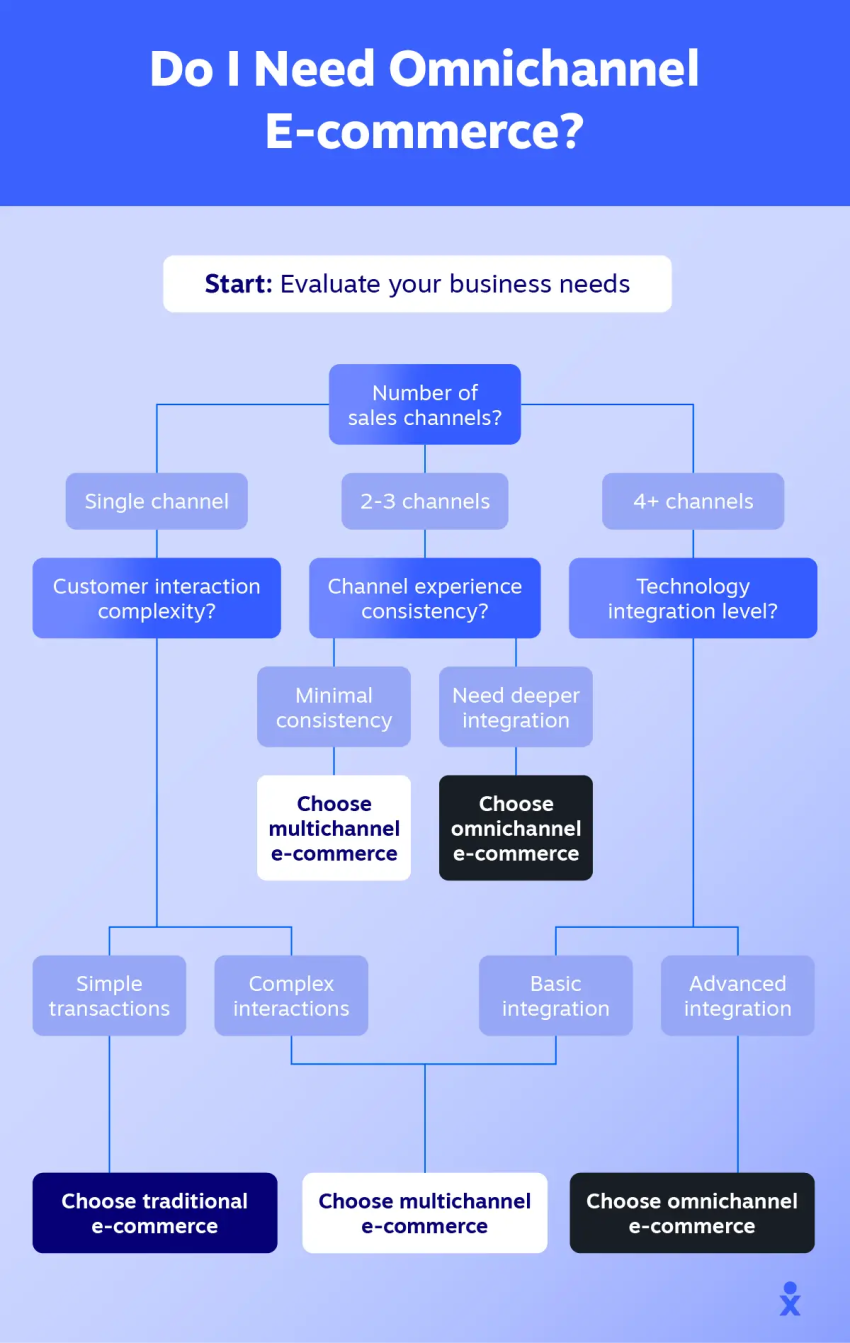
The Challenges of Omnichannel E-commerce
Along with the benefits of adopting omnichannel e-commerce, there may come a few challenges. Here are a few that may arise and how to navigate them.
Maintaining consistent customer experiences
The success of an omnichannel e-commerce strategy depends on providing an exceptional experience across all channels. Each channel, website, app, or social media might have limitations in what it can display or how it can function. Ensuring a consistent look, feel , and uniformity in branding, messaging, and user experience requires careful communication and coordination among teams.
Our 2024 State of Customer Experience Report found that one in five business leaders said that empathy from customer reps was one of the most important priorities in CX. Without an omnichannel contact center, agents have difficulty seeing previous customer interactions and can’t easily understand customer sentiment — making it more challenging to provide empathy during interactions. That’s why it’s important to have systems in place that help agents to provide empathetic, context-driven support.For example, a promotion advertised on social media should be easily redeemable both online and in-store, with consistent messaging and terms.
| 🤝 Using an omnichannel contact center software helps businesses provide superb customer experiences across every touchpoint in the customer journey, including chatbots, mobile apps, text messaging, and social media — all from a unified interface. |
Integrating data and gaining a unified customer view
Collecting and integrating customer data from disparate sources, such as CRM systems, POS systems, website analytics, and social media platforms, to create a single, unified customer view is a complex process. Without this unified view, businesses cannot effectively personalize experiences, measure ROI across channels, or understand the complete customer journey.
To overcome this, businesses should invest in data integration tools that can connect data from various sources and consider implementing a Customer Data Platform (CDP) to centralize and manage customer data. It’s also crucial to ensure compliance with data privacy regulations, such as GDPR and CCPA.
For example, if a customer frequently engages with your brand on Instagram but rarely visits your website, integrating this data allows you to tailor marketing messages and offers accordingly.
Tracking and managing inventory in real time
Multiple sales channels can make inventory management a challenge. Retail and e-commerce stores that provide an omnichannel experience need to be able to track and manage stock in real time to avoid negative customer experiences. If your systems have trouble updating inventory data in real time, a product may show as available online when it’s actually out of stock. This can lead to upset customers and extra work for support teams to process refunds and contact customers to advise them of the situation.
| 🔎 Software that integrates with e-commerce apps can offer real-time visibility into stock levels across all channels, including physical stores and online marketplaces. This ensures customers don’t order out-of-stock items and prevents overselling. |
Breaking down organizational silos
Implementing an effective omnichannel e-commerce strategy requires collaboration between different departments, including marketing, sales, customer service, IT, and logistics. Siloed departments lead to inconsistent messaging, disjointed customer experiences, and operational inefficiencies.
To address this, businesses should create dedicated omnichannel teams with representatives from different departments, establish clear communication channels and processes to ensure information sharing, and align departmental goals and KPIs to support the omnichannel strategy.
Determining which channels are most effective
Figuring out which channels work best for businesses looking to implement an omnichannel e-commerce strategy can be tricky. Whichever channels you choose, remember that the key to a successful omnichannel e-commerce strategy is to integrate them quickly and easily so you can provide a consistent brand experience across all touchpoints.
| 📈 Invest in a flexible, scalable omnichannel CX software that has the right channels for your business. It grows with you and makes adding channels easy to meet changing business needs and customer expectations. |
Maintaining data security and customer privacy
With increased data collection across multiple channels, protecting sensitive customer information and complying with privacy regulations becomes more complex. Data breaches lead to financial losses, reputational damage, and legal penalties.
Businesses must prioritize data encryption, implement strict access controls to limit access to sensitive data, ensure compliance with relevant data privacy regulations, and conduct regular security audits to identify and address vulnerabilities.
How to Create an Omnichannel E-commerce Strategy
Building a successful omnichannel e-commerce strategy doesn’t have to be rocket science. Follow these steps to help you get started.
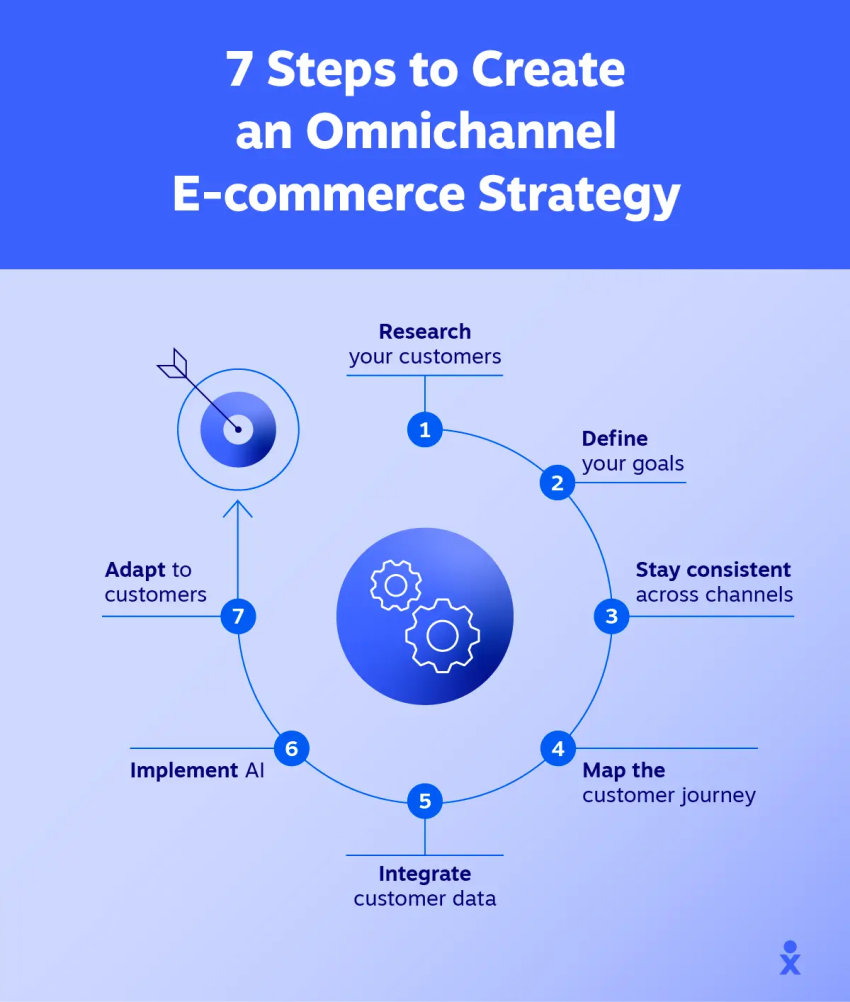
1. Research and understand your customer base
Conduct thorough market research, dive deep into customer data analytics, and collect customer feedback through surveys or social media interactions. This will provide invaluable insights into your ideal customer profile, their preferred shopping channels, and any pain points they might encounter along the customer lifecycle. Understanding your customers inside out allows you to tailor your omnichannel strategy to meet their needs and preferences more effectively.
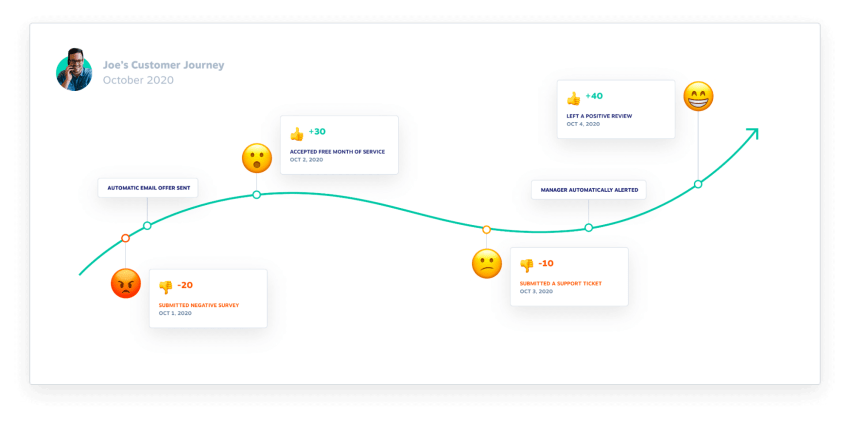
2. Define clear and measurable goals
Next, it’s time to define your goals. You need clear objectives to measure the success of your omnichannel strategy. A great way to do this is by using the SMART framework.
Make sure your goals are Specific (precisely defined), Measurable (with quantifiable metrics), Achievable (realistic and attainable), Relevant (aligned with your overall business objectives), and Time-bound (with a set timeframe). For example, instead of saying “increase sales,” a SMART goal would be: “Increase online sales by 20% within the next quarter.”
Next up, define what you want to achieve. Setting clear goals is essential for any strategy. Think about what you want your omnichannel approach to accomplish. Maybe it’s boosting online sales, improving customer retention, cutting down on customer service costs, or increasing customer lifetime value.
3. Maintain consistent brand experiences
Make sure your brand sounds the same no matter where customers find you. That means using the same tone of voice, style of writing, and messaging on your website, app, social media pages, and even in your physical stores. Whether someone’s reading your tweets or chatting with your staff in-store, they should feel like they’re talking to the same friendly, helpful brand. Consistent messaging and tone create a cohesive brand experience that builds trust and improves customer loyalty.
4. Create a customer journey map
Picture all the different ways people interact with your brand, from the first time they hear about it to when they buy something and even afterward. This map shows you where you’re doing great and where you could do better to make things smoother for customers. It’s like drawing a map of the entire customer journey with your brand so you can see exactly where to add those personal touches and make every step feel just right for them.
5. Integrate customer data and systems
Gathering customer data from every touchpoint may be challenging because of the amount of channels involved. Invest in a customer relationship management (CRM) system to consolidate data from various sales channels, marketing platforms, and customer service interactions.
This centralized repository offers a comprehensive view of customer journeys, improving analysis of behavior and preferences across touchpoints. You can utilize this insight to tailor marketing campaigns, offer personalized recommendations, and ensure consistency in the customer experience — the ingredients for driving engagement and business growth.
6. Implement AI and automation
Leverage AI-powered tools to enhance your omnichannel strategy, such as AI chatbots that offer 24/7 customer support, personalized product recommendations, and automated email marketing campaigns. AI-powered workflows can automatically route incoming requests and provide agents with real-time customer insights, like customer intent and sentiment, so they can deliver more personalized assistance.
7. Adapt to changing customer behaviors
Stay tuned in to how your customers are shopping and industry trends. Be flexible and ready to tweak your omnichannel strategy whenever new data or innovative technology comes along. This way, you can always stay ahead of the curve and make sure your approach is spot-on for what your customers want right now — while also keeping an eye on the future.based on new data, shifting customer behavior, and what’s happening in the market.
Related: Omnichannel Customer Journey: The Key to Exceptional CX
Nextiva Helps You Enhance CX with Omnichannel E-commerce
Customers have endless shopping options, making it even more important for your business to provide a convenient and effortless experience. Nextiva’s AI-powered retail management software enables you to create an omnichannel e-commerce platform that helps you provide more personalized customer experiences and consistent brand voice and messaging across every touchpoint. With Nextiva, your businesses can make deeper connections with customers, boost sales, and outshine competitors.
CX software service done right.
Integrate secure phone service, SMS, video, and team chat in ONE platform.
Omnichannel E-commerce FAQs
Still have questions? Check out our omnichannel e-commerce FAQs.
Omnichannel e-commerce is great for businesses of all sizes, from small businesses to large corporations. You can provide omnichannel customer service through a user-friendly website, social media, and a mobile app for easy ordering by utilizing the right channels. This enables a convenient and personalized shopping experience for your customers, increasing sales and customer loyalty.
The right channels for your omnichannel e-commerce platform depend on your customer base and business type. Some common options include:
🔹 Website: This is your central hub and should offer an effortless shopping experience with clear product information, secure payment systems, and easy navigation.
🔹 Mobile app: A user-friendly mobile app allows customers to browse, purchase, and track orders conveniently from their smartphone, tablet, or laptop.
🔹 Social media: Platforms like Instagram, Facebook, and TikTok offer excellent opportunities to showcase products, run targeted marketing campaigns, and interact with customers directly.
🔹 Online marketplaces: Depending on your product category, marketplaces like Amazon or eBay can expand your reach and tap into a wider customer base.
🔹 Email marketing: Personalized email campaigns nurture leads, promote new products, and keep customers engaged with your brand.
One of the best omnichannel e-commerce examples is Canyon Coolers. This business offers high-quality, ultra-durable coolers, ice chests, and accessories for extreme adventures in hostile environments. With a combination of online retail and 500 storefront locations, Canyon Coolers offers seamless omnichannel e-commerce experiences with help from Nextiva.
The cost of implementing an omnichannel strategy can vary significantly depending on the complexity of the integration, the number of channels involved, and the technology solutions you choose. It’s crucial to conduct a thorough cost-benefit analysis and prioritize investments based on your business needs and budget. Starting with a phased approach can help manage costs effectively.
Several key technologies can support an omnichannel strategy, including a robust e-commerce platform, a Customer Relationship Management (CRM) system, an inventory management system, marketing automation tools, and analytics platforms. API integrations are also crucial for data flow between these systems. Cloud-based solutions can offer scalability and flexibility.
An efficient returns and exchanges process ensures customer satisfaction in omnichannel e-commerce. Customers should be able to return or exchange items regardless of where they were purchased (online or in-store). You’ll require a well-integrated inventory management system and clear return policies communicated across all channels.

















 Customer Experience
Customer Experience 










